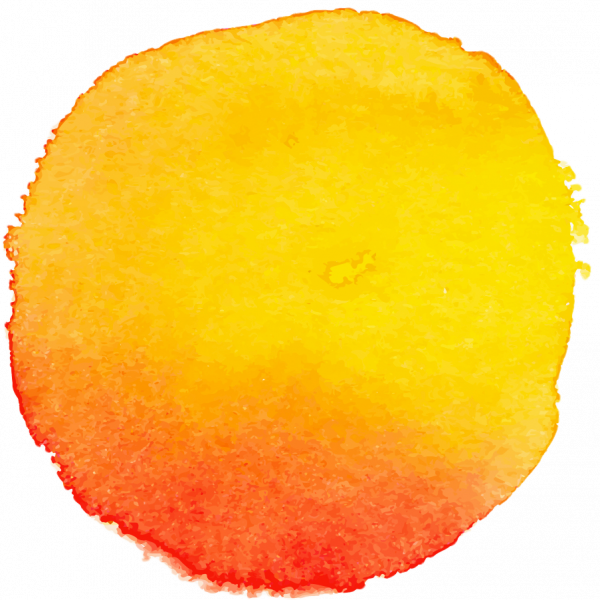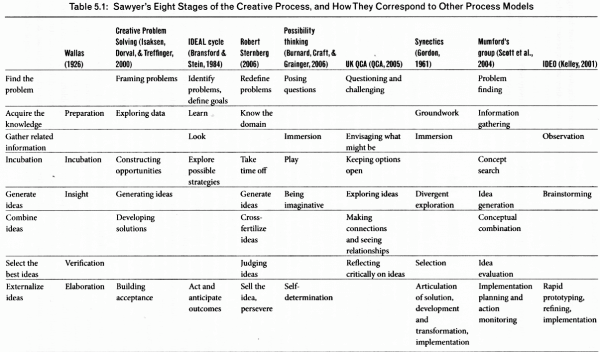Het maakproces in fasen in kaart brengen

Sawyer zet enkele belangrijke publicaties over fasen in het creatieve proces naast elkaar en maakt daar een soort van samensmelting van. Die vind je in de kolom helemaal links; the integrated framework noemt hij dat.
This integrated framework describes eight stages of the creative process:
1. Find and formulate the problem. The first step is to identify a good problem and to formulate the problem in such a way that it will be more likely to lead to a creative solution.
2. Acquire knowledge relevant to the problem. Creativity is always based on mastery, practice, and expertise.
3. Gather a broad range of potentially related information. Creativity often results from alert awareness to unexpected and apparently unrelated information in the environment.
4. Take time off for incubation. Once you’ve acquired the relevant knowledge, and some amount of apparently unrelated information, the unconscious mind will process and associate that information in unpredictable and surprising ways.
5. Generate a large variety of ideas. Unconscious incubation supports the generation of potential solutions to the problem, but conscious attention to the problem can also result in potential solutions.
6. Combine ideas in unexpected ways. Many creative ideas result from a combination of existing mental concepts or ideas.
7. Select the best ideas, applying relevant criteria. The creative process typically results in a large number of potential solutions. Most of them will turn out not to be effective solutions; successful creators must be good at selecting which ideas to pursue further.
8. Externalize the idea using materials and representations. Creativity isn’t just having an idea; creative ideas emerge, develop, and transform as they are expressed in the world.
The consensus resulting from cognitive psychology is that creativity isn’t a single, unitary mental process. Instead, creativity results from many different mental processes, each associated with one of the eight stages.
The research presented here shows that the conscious mind plays an important role in the creative process. Stages 1, 2, and 3 are predominantly conscious and directed. Even Stage 4, incubation, occurs only in the context of ongoing conscious work – you benefit from incubation only if you work hard on a problem beforehand, and then continue to work hard on it afterwards.
[…] studies have found that creators work on many problems at the same time, and that in most creative careers, an insight often generates more questions than it answers. A creative insight that generates good questions is more valuable than one that conclusively answers every known question but doesn’t suggest any further research. The task of solving a good question leads to the reformulation of difficult problems and the generation of completely new questions.
Psychoanalytic theorists were some of the first to explore the cyclical nature of mini-insights. Arieti (1976) noted that “complex works that can be divided into parts” involve a series of insights, with incubation occurring throughout the creative process, and he concluded that the stages of creativity aren’t separated through time (p. 18). Rothenberg (1979) argued that creation isn’t found in a single moment of insight but is “a long series of circumstances . . . often interrupted, reconstructed, and repeated” (p. 131). He criticized stage theories, arguing that “the temporal distinction made between inspiration and elaboration in the creative process is an incorrect one; these phases or functions alternate – sometimes extremely rapidly – from start to finish” (p. 346). And Vinacke (1952) argued that in many creative fields, especially fine art, the final work results from a series of insights beginning with the first draft or sketch and continuing until the work is completed. Incubation doesn’t occur in a particular stage but operates to varying degrees throughout the creative process. For example, poems and plays don’t emerge suddenly or completely but are gradually developed through a process of many incubations and insights.
At the end of our exploration of the eight-stage creative process, it seems clear that the moment of insight is overrated. It’s only one small component of a complex creative process, and it’s not all that mysterious. The typical creator experiences many small mini-insights every day, and these mini-insights can be traced back to the material he or she was consciously working on. We only think we see dramatic leaps of insight because we didn’t observe the many small, incremental steps that preceded it. Instead of the light bulb, a better metaphor for an insight would be the tip of an iceberg, or the final brick in a wall.
The mythical view of a moment of insight overly simplifies the complexity and hard work of most creativity. Instead of a single glorious moment, creators experience small insights throughout a day’s work, with each small insight followed by a period of evaluation and externalization; these mini-insights only gradually accumulate to result in a finished work, as a result of a process of hard work and intellectual labor of the creator.
Bron: Sawyer, R. K. (2012) Explaining creativity: The science of human innovation. Oxford University Press.
Verder lezen: Fasenmodellen hebben het voordeel van de overzichtelijkheid maar hebben ook nadelen.
